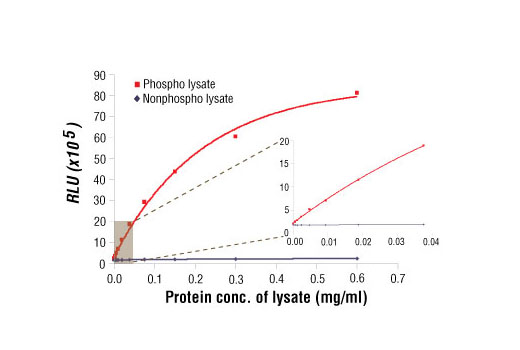| Product Includes | Product # | Quantity | Color | Storage Temp |
|---|---|---|---|---|
| FLT3 Mouse mAb Coated Microwells | 85498 | 96 tests |
|
+4C |
| Phospho-FLT3 (Tyr591) Rabbit Detection Antibody | 14073 | 1 ea |
|
+4C |
| Anti-rabbit IgG, HRP-linked Antibody (ELISA Formulated) | 13272 | 1 ea |
|
+4C |
| Detection Antibody Diluent | 13339 | 5.5 ml |
|
+4C |
| HRP Diluent | 13515 | 5.5 ml |
|
+4C |
| Luminol/Enhancer Solution | 84850 | 3 ml |
|
RT |
| Stable Peroxide Buffer | 42552 | 3 ml |
|
RT |
| Sealing Tape | 54503 | 2 ea |
|
+4C |
| ELISA Wash Buffer (20X) | 9801 | 25 ml |
|
+4C |
| ELISA Sample Diluent | 11083 | 25 ml |
|
+4C |
| Cell Lysis Buffer (10X) | 9803 | 15 ml |
|
-20C |
*The microwell plate is supplied as 12 8-well modules - Each module is designed to break apart for 8 tests.
Description
The PathScan® Phospho-FLT3 (Tyr591) Chemiluminescent Sandwich ELISA Kit is a solid phase sandwich enzyme-linked immunosorbent assay (ELISA) that detects endogenous levels of phospho-FLT3 (Tyr591) protein with a chemiluminescent readout. Chemiluminescent ELISAs often have a wider dynamic range and higher sensitivity than conventional chromogenic detection. This chemiluminescent ELISA, which is offered in low volume microplates, shows increased signal and sensitivity while using a smaller sample size. A FLT3 Mouse mAb has been coated on the microwells. After incubation with cell lysates, FLT3 (phospho or nonphospho) protein is captured by the coated antibody. Following extensive washing, a phospho-FLT3 (Tyr 591) Rabbit Antibody is added to detect the captured phospho-FLT3 protein. Anti-rabbit IgG, HRP-linked antibody is then used to recognize the bound detection antibody. Chemiluminescent reagent is added for signal development. The magnitude of light emission, measured in relative light units (RLU), is proportional to the quantity of phospho-FLT3 (Tyr591) protein.
*Antibodies in this kit are custom formulations specific to kit.
Specificity/Sensitivity
Background
FMS-related tyrosine kinase 3 (FLT3, also called FLK2) is a member of the Type III receptor tyrosine kinase family, which includes c-Kit, PDGFR, and M-CSF receptors. FLT3 is expressed on early hematopoietic progenitor cells and supports growth and differentiation within the hematopoietic system (1,2). FLT3 is activated after binding with its ligand FL, which results in a cascade of tyrosine autophosphorylation and tyrosine phosphorylation of downstream substrates (3). The p85 subunit of PI3 kinase, SHP2, GRB2, and Shc have all been reported to associate with FLT3 after FL stimulation (4-6). Tyr589/591 is located in the juxtamembrane region of FLT3 and may play an important role in regulation of FLT3 tyrosine kinase activity. Somatic mutations of FLT3 consisting of internal tandem duplications (ITDs) occur in 20% of patients with acute myeloid leukemia (7).
- Shurin, M.R. et al. (1998) Cytokine Growth Factor Rev 9, 37-48.
- Naoe, T. et al. (2001) Cancer Chemother Pharmacol 48 Suppl 1, S27-30.
- Namikawa, R. et al. (1996) Stem Cells 14, 388-95.
- Beslu, N. et al. (1996) J Biol Chem 271, 20075-81.
- Zhang, S. and Broxmeyer, H.E. (2000) Biochem Biophys Res Commun 277, 195-9.
- Zhang, S. et al. (1999) J Leukoc Biol 65, 372-80.
- Mizuki, M. et al. (2000) Blood 96, 3907-14.
Background References
Cross-Reactivity Key
H: human M: mouse R: rat Hm: hamster Mk: monkey Vir: virus Mi: mink C: chicken Dm: D. melanogaster X: Xenopus Z: zebrafish B: bovine Dg: dog Pg: pig Sc: S. cerevisiae Ce: C. elegans Hr: horse GP: Guinea Pig Rab: rabbit All: all species expected
Trademarks and Patents
Limited Uses
Except as otherwise expressly agreed in a writing signed by a legally authorized representative of CST, the following terms apply to Products provided by CST, its affiliates or its distributors. Any Customer's terms and conditions that are in addition to, or different from, those contained herein, unless separately accepted in writing by a legally authorized representative of CST, are rejected and are of no force or effect.
Products are labeled with For Research Use Only or a similar labeling statement and have not been approved, cleared, or licensed by the FDA or other regulatory foreign or domestic entity, for any purpose. Customer shall not use any Product for any diagnostic or therapeutic purpose, or otherwise in any manner that conflicts with its labeling statement. Products sold or licensed by CST are provided for Customer as the end-user and solely for research and development uses. Any use of Product for diagnostic, prophylactic or therapeutic purposes, or any purchase of Product for resale (alone or as a component) or other commercial purpose, requires a separate license from CST. Customer shall (a) not sell, license, loan, donate or otherwise transfer or make available any Product to any third party, whether alone or in combination with other materials, or use the Products to manufacture any commercial products, (b) not copy, modify, reverse engineer, decompile, disassemble or otherwise attempt to discover the underlying structure or technology of the Products, or use the Products for the purpose of developing any products or services that would compete with CST products or services, (c) not alter or remove from the Products any trademarks, trade names, logos, patent or copyright notices or markings, (d) use the Products solely in accordance with CST Product Terms of Sale and any applicable documentation, and (e) comply with any license, terms of service or similar agreement with respect to any third party products or services used by Customer in connection with the Products.
